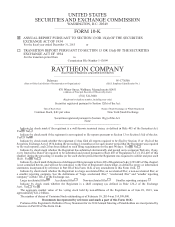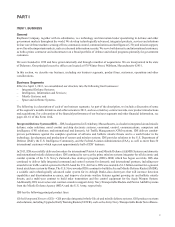Raytheon 2013 Annual Report Download - page 18
Download and view the complete annual report
Please find page 18 of the 2013 Raytheon annual report below. You can navigate through the pages in the report by either clicking on the pages listed below, or by using the keyword search tool below to find specific information within the annual report.
8
addition, because we are engaged in supplying technologically-advanced, cutting edge defense-related products and services
to the U.S. Government, we are subject to certain business risks, some of which are specific to our industry. These risks
include: the cost of obtaining and retaining trained and skilled employees; the uncertainty and instability of prices for raw
materials and supplies; the problems associated with advanced designs, which may result in unforeseen technological
difficulties and cost overruns; and the intense competition and the constant necessity for improvement in facility utilization
and personnel training. Our sales to the U.S. Government may be affected by changes in procurement policies, budget
considerations, changing priorities for national defense, political developments abroad and other factors. See Item 1A “Risk
Factors” and “Overview” within Item 7 of this Form 10-K for a more detailed discussion of these and other related risks.
We are also involved in U.S. Government programs, principally through our IIS and SAS business segments, that are classified
by the U.S. Government and cannot be specifically described in this Form 10-K. The operating results of these classified
programs are included in the applicable business segment's and our consolidated results of operations. The business risks and
considerations associated with these and our international classified programs generally do not differ materially from those
of our other programs and products. Total classified sales were 15% in 2013 and 16% in both 2012 and 2011.
We are subject to government regulations and contract requirements that may differ from U.S. Government regulation with
respect to our sales to non-U.S. customers. See “International Sales” below for more information regarding our sales outside
of the U.S. and Item 1A “Risk Factors” for a discussion of the risks associated with international sales.
See “Sales to the U.S. Government” on page 6 of this Form 10-K for information regarding the percentage of our revenues
generated from sales to the U.S. Government.
International Sales
(In millions, except percentages) 2013 2012 2011
Total international sales(1) $ 6,446 $ 6,232 $ 6,139
Total international sales as a Percentage of Total Net Sales(1) 27% 26% 25%
(1) Includes foreign military sales through the U.S. Government.
International sales were principally in the areas of air and missile defense systems, missile systems, airborne radars, naval
systems, air traffic control systems, electronic equipment, computer software and systems, personnel training, equipment
maintenance and microwave communications technology, and other products and services permitted under the International
Traffic in Arms Regulations (ITAR). Generally, we finance our foreign subsidiary working capital requirements in the
applicable countries. Sales and income from international operations and investments are subject to U.S. Government laws,
regulations and policies, including the ITAR and the Foreign Corrupt Practices Act (FCPA) and other anti-corruption laws
and the export laws and regulations described below. They are also subject to foreign government laws, regulations and
procurement policies and practices, which may differ from U.S. Government regulation, including import-export control,
technology transfer, investments, exchange controls, repatriation of earnings and requirements to expend a portion of program
funds in-country through manufacturing agreements or other financial support obligations, known as offset obligations. In
addition, embargoes, international hostilities and changes in currency values can also impact our international sales. Exchange
restrictions imposed by various countries could restrict the transfer of funds between countries, us and our subsidiaries. We
have acted to protect ourselves against various risks through insurance, foreign exchange contracts, contract provisions,
government guarantees and/or progress payments. See revenues derived from external customers and long-lived assets by
geographical area set forth in “Note 15: Business Segment Reporting” within Item 8 of this Form
In connection with certain foreign sales, we utilize the services of sales representatives who are paid commissions in return
for services rendered.
The export from the U.S. of many of our products may require the issuance of a license by either the U.S. Department of State
under the Arms Export Control Act of 1976 (formerly the Foreign Military Sales Act) and its implementing regulations under
the ITAR, the U.S. Department of Commerce under the Export Administration Act and its implementing regulations as kept
in force by the International Emergency Economic Powers Act of 1977 (IEEPA), and/or the U.S. Department of the Treasury
under IEEPA or the Trading with the Enemy Act of 1917. Such licenses may be denied for reasons of U.S. national security
or foreign policy. In the case of certain exports of defense equipment and services, the Department of State must notify Congress
at least 15–30 days (depending on the identity of the importing country that will utilize the equipment and services) prior to
























